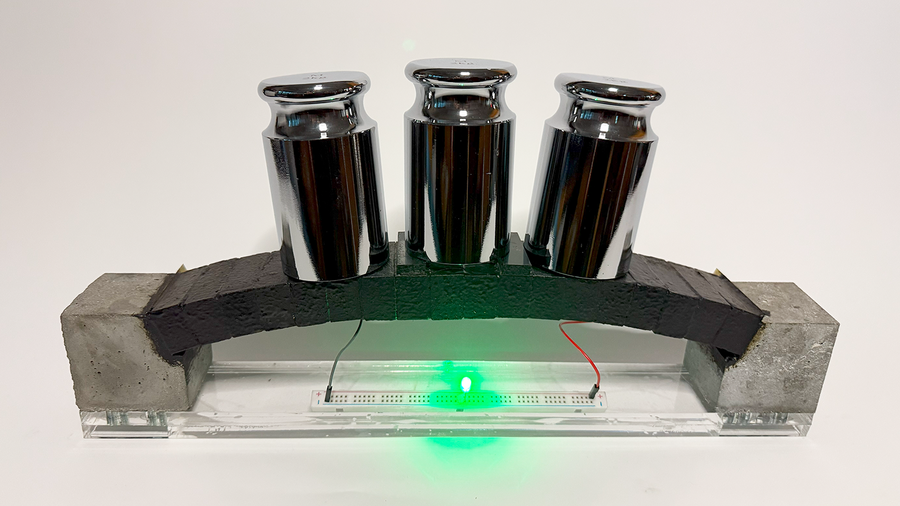Self-healing 'concrete batteries' now 10 times better — they could one day power cities, scientists say
Called ec³, the material is made by combining cement and water with a liquid electrolyte and carbon powder — both readily available.

MIT researchers have improved a new type of "concrete battery" by tenfold, paving the way for its use in turning buildings, bridges and sidewalks into giant energy stores capable of powering entire cities.
The material is called electron-conducting carbon concrete — or ec³ — and is made by combining cement, water, a common liquid electrolyte and an extremely fine carbon powder called nanoscale carbon black.
When mixed together, the ingredients create a dense, conductive network capable of carrying an electrical charge. Once set into concrete, the material and anything built from it (whether they’re buildings and bridges or pavements) is able to store and release energy as needed.
It’s a concept known as supercapacitive energy storage, and researchers hope it can offer a viable solution to one of renewable energy's biggest challenges: namely, how to store power locally when the sun isn't shining or the wind isn't blowing.
In a new study published Sept. 29 in the journal Proceedings of the National Academy of Sciences (PNAS), researchers said they achieved a tenfold increase in the energy storage capacity of ec³ since 2023. Fivecubic meters (176.5 cubic feet) of the material can now store more than 10 kilowatt-hours of electricity — roughly enough to power a typical household for a day.
Just two years ago, achieving that level of storage would have required nine times the volume, the team said.
Get the world’s most fascinating discoveries delivered straight to your inbox.
"With these higher energy densities and demonstrated value across a broader application space, we now have a powerful and flexible tool that can help us address a wide range of persistent energy challenges," lead author of the study Damian Stefaniuk, research scientist at MIT, said in a statement.
"One of our biggest motivations was to help enable the renewable energy transition. Solar power, for example, has come a long way in terms of efficiency. However, it can only generate power when there's enough sunlight. So, the question becomes: How do you meet your energy needs at night, or on cloudy days?"
Building batteries
While ec³ doesn't match the energy density of traditional battery technologies like lithium-ion (which pack hundreds of times more energy into the same weight or volume), the fact that it can be cast directly into building components and may last as long as the structure itself, without relying on scarce or toxic materials, makes it especially attractive to scientists.
The new performance boost came from a better understanding of the interaction between the carbon network inside the concrete and the electrolyte and from changes to how the material is made.
Rather than soaking slabs of the material in the electrolyte after it hardened, the researchers added the electrolyte directly to the water used in the initial mix. That enabled the production of thicker, more energy-dense slabs without compromising conductivity.
The team also tested different types of electrolytes, including seawater, and found several viable options. The best results came from a mix of quaternary ammonium salts — used in household disinfectants — and acetonitrile, a conductive solvent common in industrial processes.
Powering the block
Most exciting to the scientists was the realization that it only took small changes to how concrete is made to produce ec³. This potentially opens up huge opportunities in sustainable construction, where the material could be used to develop what the researchers dubbed "multifunctional concrete" that can store energy, absorb carbon dioxide from the atmosphere, and even repair itself.
The material has already been tested in Japan to heat sidewalks in snowy conditions, offering a potential alternative to road salt. The team is now working toward real-world applications, from homes that operate off-grid to parking spaces and roads that could one day charge electric vehicles.
"What excites us most is that we've taken a material as ancient as concrete and shown that it can do something entirely new," study co-author James Weaver, associate professor of materials science and engineering at Cornell University, said in the statement.
"By combining modern nanoscience with an ancient building block of civilization, we're opening a door to infrastructure that doesn't just support our lives, it powers them."
Owen Hughes is a freelance writer and editor specializing in data and digital technologies. Previously a senior editor at ZDNET, Owen has been writing about tech for more than a decade, during which time he has covered everything from AI, cybersecurity and supercomputers to programming languages and public sector IT. Owen is particularly interested in the intersection of technology, life and work – in his previous roles at ZDNET and TechRepublic, he wrote extensively about business leadership, digital transformation and the evolving dynamics of remote work.
You must confirm your public display name before commenting
Please logout and then login again, you will then be prompted to enter your display name.

